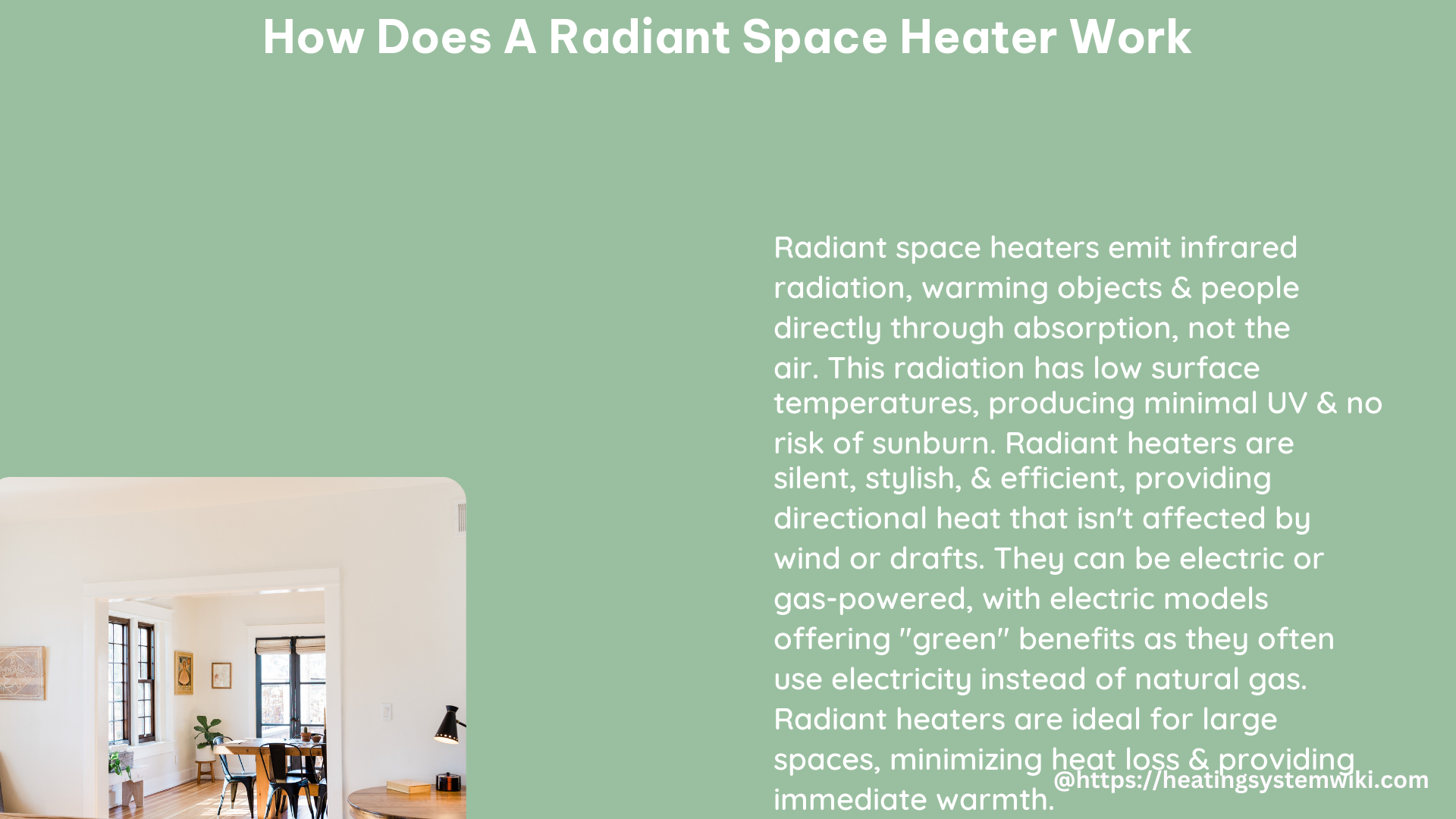Radiant space heaters work by converting electrical or gas energy into infrared radiation, which then heats up objects and people in the surrounding area. Unlike traditional convection heaters that warm the air, radiant heaters directly transfer heat to the surfaces they face, making them a more efficient and targeted heating solution. Let’s dive into the technical details of how these innovative heaters function.
Heat Production: Infrared Radiation
At the core of a radiant space heater’s operation is the production of infrared radiation. This invisible electromagnetic radiation is similar to the heat we feel from the sun, but without the visible light. Radiant heaters generate this infrared energy through two primary methods:
-
Gas-Powered Radiant Heaters: These models use a mixture of gas and air that is ignited by an electrode. The resulting flame heats up a metal or ceramic tube, which then emits the infrared radiation.
-
Electric Radiant Heaters: These heaters run an electric current through coils made of metal, such as nichrome or stainless steel. The resistance in the coils converts the electrical energy into thermal energy, which is then radiated outwards.
The wavelength of the infrared radiation produced by radiant heaters typically ranges from 2.5 to 50 micrometers, with the most efficient models targeting the 4 to 7 micrometer range. This specific wavelength range is optimal for directly heating objects and people, rather than just warming the surrounding air.
Heat Transfer: Direct Warming

Unlike convection heaters that warm the air, radiant heaters transfer heat through direct radiation. When the infrared waves emitted by the heater encounter a surface, they are absorbed, causing the surface temperature to rise. This direct heating of objects and people is what makes radiant heaters so efficient and effective.
The key characteristics of radiant heat transfer include:
- Immediate Warming: You’ll feel the warmth from a radiant heater almost instantly when it’s turned on, as the infrared waves directly heat the surfaces in their path.
- Line-of-Sight Heating: The radiant heat only warms the objects and people that are in the direct line of sight of the heater. The air itself is not heated, but rather warms up through contact with the heated surfaces.
- Increased Intensity with Proximity: As the distance between the heater and the target surface decreases, the intensity of the radiant heat increases, providing more focused and intense warmth.
This direct heating of surfaces, rather than just the air, is what makes radiant heaters particularly effective in large, open spaces or rooms with high ceilings, where convection heaters may struggle to efficiently distribute warmth.
Radiant Heater Models
There are several different types of radiant space heaters, each with its own unique features and applications:
-
Wall-Mounted Radiant Heaters: These slim, space-saving heaters are mounted on the wall, providing a more balanced radiant heat distribution from the floor to the ceiling, compared to traditional radiators that can make the feet feel hotter than the rest of the body.
-
Permanent Floor Radiant Heaters: These heaters are installed directly underneath the floor surface, often in bathrooms, to warm up cold tiles and provide a cozy, comfortable environment.
-
Permanent Ceiling Radiant Heaters: These heaters feature panels attached to the ceiling that radiate heat downwards, targeting the occupants below with efficient, focused warmth.
-
Free-Standing Floor Space Radiant Heaters: These portable, floor-standing models are smaller and easier to move from room to room, making them ideal for heating small, localized spaces.
Each of these radiant heater types offers unique advantages in terms of installation, heating coverage, and energy efficiency, allowing homeowners and building managers to choose the best solution for their specific heating needs.
Efficiency and Advantages
Radiant space heaters are generally more efficient than traditional convection heaters for several reasons:
-
Higher Heat Transfer Rate: Radiant heat has a higher rate of heat transfer per kilowatt than convection, meaning you need less energy to achieve the same level of warmth. For example, Herschel infrared panels only require 70 Watts per 100 ft³, compared to 110 Watts per 100 ft³ for convection heaters.
-
Targeted Heating: By directly heating the surfaces and objects in their line of sight, radiant heaters avoid the energy loss associated with heating the air, which then has to transfer its heat to the surrounding surfaces.
-
Thermal Mass Buildup: Radiant heaters warm the walls, floors, and ceilings of a building, creating a “thermal mass” that can store and radiate heat, keeping the space warm even after the heater is turned off.
-
Comfort and Efficiency: The direct heating of surfaces and objects, rather than just the air, provides a more comfortable and efficient heating experience, as the warmth is felt immediately and more evenly distributed throughout the space.
These advantages make radiant space heaters a popular choice for a variety of applications, from short-term room occupancy to heating large, open spaces and rooms with high ceilings.
References:
– Radiant Heaters: How They Work and When to Use Them
– How Infrared Heaters Work
– What is a Radiant Heater and When Should You Use One?
– The Science Behind Infrared Heating
– Radiant Heating vs. Convection Heating: What’s the Difference?
